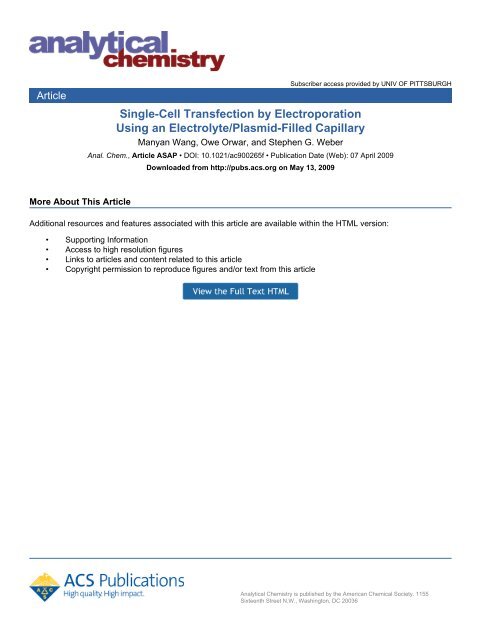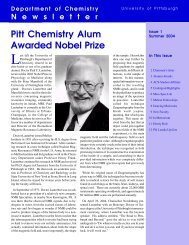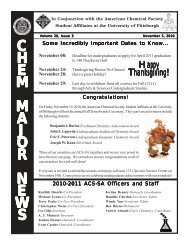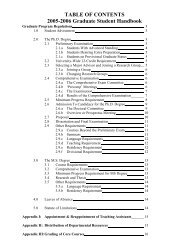Single-Cell Transfection by Electroporation Using an Electrolyte ...
Single-Cell Transfection by Electroporation Using an Electrolyte ...
Single-Cell Transfection by Electroporation Using an Electrolyte ...
Create successful ePaper yourself
Turn your PDF publications into a flip-book with our unique Google optimized e-Paper software.
Article<strong>Single</strong>-<strong>Cell</strong> <strong>Tr<strong>an</strong>sfection</strong> <strong>by</strong> <strong>Electroporation</strong><strong>Using</strong> <strong>an</strong> <strong>Electrolyte</strong>/Plasmid-Filled CapillaryM<strong>an</strong>y<strong>an</strong> W<strong>an</strong>g, Owe Orwar, <strong>an</strong>d Stephen G. WeberSubscriber access provided <strong>by</strong> UNIV OF PITTSBURGHAnal. Chem., Article ASAP • DOI: 10.1021/ac900265f • Publication Date (Web): 07 April 2009Downloaded from http://pubs.acs.org on May 13, 2009More About This ArticleAdditional resources <strong>an</strong>d features associated with this article are available within the HTML version:• Supporting Information• Access to high resolution figures• Links to articles <strong>an</strong>d content related to this article• Copyright permission to reproduce figures <strong>an</strong>d/or text from this articleAnalytical Chemistry is published <strong>by</strong> the Americ<strong>an</strong> Chemical Society. 1155Sixteenth Street N.W., Washington, DC 20036
<strong>an</strong>d rat hippocampal slices. 11 Their highest tr<strong>an</strong>sfection efficiencywas only 30% after optimization of the pulse protocols. The poortr<strong>an</strong>sfection efficiency has been improved in two different approachesthat are based on electroinjection, i.e., the plasmid-filledcapillary is in direct physical contact with the cell membr<strong>an</strong>e. First,Rae <strong>an</strong>d Levis pressed a smaller (0.5 µm) tip onto the target cellswhile monitoring the resist<strong>an</strong>ce increase. 10 Second, Kitamura etal. coupled the whole-cell patch-clamp technique with two-photonmicroscopy 9 for in vivo tr<strong>an</strong>sfection of neurons with plasmidencoding EGFP. 7 This micropipet method was also successfullyapplied to the delivery of RNA into neurons recently <strong>by</strong> Boudeset al. 8 Despite the above adv<strong>an</strong>ces, problems arise, as addressed<strong>by</strong> Rae <strong>an</strong>d Levis, from the cell damage caused <strong>by</strong> indenting, themicropipet tip clogging, <strong>an</strong>d cell adhesion to the tips after pulses.Recently, microchips coupling microelectrodes have been designedfor high-throughput SCEP <strong>an</strong>d show promising results forgene delivery into single cells. 12-14 However, this approach is notsuitable for adherent cells, tissue slices, tissue cultures, or in vivoapplications. Although m<strong>an</strong>y papers have reported the effect ofthe electrical pulsing protocol on plasmid tr<strong>an</strong>sfer during SCEPor bulk electroporation, 10,13,15 nobody has tried to correlate cellmembr<strong>an</strong>e permeability to small molecules with DNA delivery.As we have shown previously, 16,17 exposing cells to the thiolreactivefluorogenic reagent, ThioGlo 1, leads to intracellularfluorescence, chiefly from the freely diffusible reduced glutathione(γ-Glu-Cys-Gly, GSH). Thus, in this work, we follow the loss ofintracellular fluorescence (from ThioGlo 1-labeled thiols) fromsingle cells being electroporated with a pEGFP-C2 plasmid-filledcapillary with fine tips. The results show that this method of genedelivery is effective, <strong>an</strong>d that gene delivery into cells is related tothe extent of electroporation as indicated <strong>by</strong> the extent of labeledthiol loss from cells.MATERIALS AND METHODSMaterials. The chemicals used for buffers were all of <strong>an</strong>alyticalgrade <strong>an</strong>d purchased from Sigma (St. Louis, MO). The HEPESbufferedsaline solution, which we will call “extracellular buffer”,consisted of NaCl (140 mM), KCl (5 mM), MgCl 2 (1.5 mM),CaCl 2 (2 mM), D-glucose (10 mM), <strong>an</strong>d HEPES (20 mM). ThepH was adjusted to 7.4 with 0.5 M NaOH, <strong>an</strong>d the buffer wasfiltered with 0.45 µm nylon filters prior to use. Plasmid pEGFP-C2 vector (donated <strong>by</strong> Dr. Michael Trakselis) was precipitatedwith eth<strong>an</strong>ol <strong>an</strong>d resuspended in extracellular buffer to a finalconcentration of 0.16-0.78 µg/µL (measured <strong>by</strong> UV absorb<strong>an</strong>ceat 260 nm). Thioglo 1 was purchased from CovalentAssociates (Woburn, MA). A549 cell lines were obtained fromAmeric<strong>an</strong> Type Culture Association (M<strong>an</strong>assas, VA). BasalMedium Eagle (BME), 0.25% trypsin-EDTA, One Shot fetalbovine serum (FBS), L-glutamine, <strong>an</strong>d penicillin-streptomycin(12) W<strong>an</strong>g, H. Y.; Lu, C. Biotechnol. Bioeng. 2008, 100, 579–586.(13) Vass<strong>an</strong>elli, S.; B<strong>an</strong>diera, L.; Borgo, M.; <strong>Cell</strong>ere, G.; S<strong>an</strong>toni, L.; Bers<strong>an</strong>i, C.;Salamon, M.; Zaccolo, M.; Lorenzelli, L.; Girardi, S.; Maschietto, M.; DalMaschio, M.; Paccagnella, A. N. Biotechnol. 2008, 25, 55–67.(14) Valero, A.; Post, J. N.; v<strong>an</strong> Nieuwkasteele, J. W.; ter Braak, P. M.; Kruijer,W.; v<strong>an</strong> den Berg, A. Lab Chip 2008, 8, 62–67.(15) Rols, M.-P.; Teissie, J. Biophys. J. 1998, 75, 1415–1423.(16) Agarwal, A.; Zud<strong>an</strong>s, I.; Orwar, O.; Weber, S. G. Anal. Chem. 2007, 79,161–167.(17) Agarwal, A.; Zud<strong>an</strong>s, I.; Weber, E. A.; Olofsson, J.; Orwar, O.; Weber, S. G.Anal. Chem. 2007, 79, 3589–3596.solution were all obtained from Invitrogen, GIBCO (Carlsbad,CA). Milli-Q (Millipore Synthesis A10, Billerica, MA) water wasused. Pt wires (diameter 0.5 mm, high purity 99.99+%) werepurchased from Goodfellow (Oakdale, PA).<strong>Cell</strong> Culture <strong>an</strong>d Preparation. A549 hum<strong>an</strong> lung carcinomacells were cultured for tr<strong>an</strong>sfection. The culture medium wasprepared <strong>by</strong> adding 50 mL of FBS, 5 mL of 200 mM L-glutamine,<strong>an</strong>d 5 mL of 10 000 units/mL of penicillin-10 000 µg/mL streptomycinto 500 mL of BME. <strong>Cell</strong>s were grown in 75 cm 2 cellculture flasks (Nunc* Sterile EasYFlask) in a CO 2 incubator(HERA cell incubator, Newtown, CT) at 37 °C <strong>an</strong>d 5% CO 2 /95% air <strong>an</strong>d were subcultured when reaching ∼80% confluenceevery 3-4 days. Before the experiments, cells were seededon 35 mm gridded uncoated glass-bottom cell culture dishes(MatTek Corp., Ashl<strong>an</strong>d, MA) at a seeding density of 1 × 10 4cells/dish. Experiments were performed on the second <strong>an</strong>dthird days following the cell plating.Thioglo 1 Staining for <strong>Electroporation</strong> Visualization. Astock solution of ThioGlo 1 was prepared at a concentration of0.5 mM in pure DMSO <strong>an</strong>d stored in a desiccator at -20 °C inthe dark. A 2 µM ThioGlo 1 loading solution was freshly prepared<strong>by</strong> diluting 2 µL of ThioGlo 1 stock solution with 0.5 mL ofextracellular buffer before staining the cells. For staining, eachcell dish was first washed three times with extracellular buffer.Following the washing step, the cells were exposed to 0.5 mL ofThioGlo 1 for 30 s at room temperature. The cell dish was washedagain with extracellular buffer <strong>an</strong>d finally bathed in 2 mL ofextracellular buffer for electroporation.Capillary Fabrication. The fabrication of electrolyte-filledcapillaries (EFC) with pulled tips was done in a laminar flow hood.Fused-silica capillaries from Polymicro Technology (Phoenix, AZ)with <strong>an</strong> outer diameter of 360 µm <strong>an</strong>d <strong>an</strong> inner diameter of 100µm were used. Capillaries were pulled at one end <strong>by</strong> using a CO 2laser puller (Sutter Instruments Co. P-2000, Novato, CA).Before the capillary was pulled, a2cmcenter section of a 35cm long capillary was burned with a flame to remove theprotective polyimide coating, <strong>an</strong>d then the capillary was flushedwith prefiltered (<strong>by</strong> a 0.2 µm syringe filter) Milli-Q grade water.These capillaries were pulled to create reproducible capillarieswith a short pulled tip having <strong>an</strong> opening inner diameter of∼2 µm. Before the experiments, the capillaries were carefullytruncated with a Shortix fused-silica tubing cutter to get a finallength of 15 cm.Microscope Imaging. The cell dish was fixed in a cellchamber (DH 35i culture dish incubator, Warner Instruments,Holliston, MA) mounted on the stage of <strong>an</strong> inverted fluorescencemicroscope (Olympus IX 71, Melville, NY) coupled with a CCD(ORCA-285 IEEE 1394-Based Digital Camera,B&BMicroscopesLimited, Pittsburgh, PA) for fluorescence imaging. A Cermax 175W xenon arc lamp (PE175BF, PerkinElmer Optoelectronics,Fremont, CA) in the microscope was used as the excitation source.<strong>Cell</strong>s were observed through a 20× 0.70 NA UPl<strong>an</strong>Apo objectivelens (Olympus). Image processing was performed <strong>by</strong> the imageacquisition software SimplePCI from Compix Inc. (Sewickley, PA).Fluorescence intensities of regions of interest were corrected <strong>by</strong>subtracting the average fluorescence intensity of four near<strong>by</strong>background regions.BAnalytical Chemistry, Vol. xxx, No. xx, Month XX, XXXX
Figure 1. Schematic diagram of the experimental setup. Either of two circuits, electroporation with current monitoring or the test circuit, maybe used <strong>by</strong> throwing a switch. By switching from A to B, the active circuit converts from the test circuit to the electroporation circuit. A multipositionrotary selector switch shelled in a grounded box is used for switching. (1) Switch position at A. The test circuit is on. The function generatorproduces a2V(rms) sine wave at 100 Hz. The resulting current goes through the same path taken <strong>by</strong> the current during electroporationincluding the interface of Pt with the electrolyte, its container, the capillary, the pulled tip, the cell dish filled with buffer, the other electrolyte/Ptinterface, <strong>an</strong>d to ground through a current-to-voltage converter in a lock-in-amplifier. The lock-in amplifier has its reference input connected tothe signal output of the function generator, thus locks on the 100 Hz frequency <strong>an</strong>d gives a current reading at this specific frequency. This circuitis used for capillary <strong>an</strong>d connection testing. (2) Switch position at B. The electroporation circuit is on. An electroporator provides a high voltagepulse applied for electroporation <strong>by</strong> pushing a trigger button. The current goes through the same electrode <strong>an</strong>d electrolyte path as describedabove. It goes to ground through a resistor <strong>an</strong>d <strong>an</strong> oscilloscope in parallel. The oscilloscope is used to examine the pulse shape <strong>an</strong>d magnitudeas well as monitoring the current going through the electroporation circuit.For Thioglo 1, <strong>an</strong> Omega fluorescence filter cube (especiallybuilt, exciter XF1075-387AF28, dichroic XF2004-410DRLP, emitterXF3087-480ALP, Omega Optical, Brattleboro, VT) was used forexcitation at 378 nm <strong>an</strong>d emission at 480 nm. For EGFP imaging,a U-MWIB2 filter set from Olympus (exciter 460-490, emitter510IF, dichroic 505) was used.Experimental Circuit <strong>an</strong>d Electronics. The experimentalsetup is depicted in Figure 1. It has two switchable circuits: <strong>an</strong>electroporation circuit <strong>an</strong>d a test circuit. When doing experiments,the test circuit (described below) helps to examine the status ofthe capillary. Once the capillary is placed near a cell, the switchesare thrown to activate the electroporation circuit (described below)for electroporation accomp<strong>an</strong>ied <strong>by</strong> current monitoring.<strong>Electroporation</strong> Circuit. When the switches were put in positionB, the test circuit was inactive. The 15 cm long pulled capillarywas positioned using a MP-285 motorized microm<strong>an</strong>ipulator fromSutter (Novato, CA). The tip end was carefully placed near thetarget cell at a desired dist<strong>an</strong>ce. The other end of the capillarywas inserted into a vial filled with extracellular buffer. A platinumelectrode placed in this vial was connected to the electroporator(BTX ECM 830, Harvard Apparatus, S<strong>an</strong> Diego, CA), <strong>an</strong>d theelectrical circuit was completed with <strong>an</strong>other platinum electrodein the cell dish connected to ground through a 100 kΩ resistor,R m . The voltage across the resistor created <strong>by</strong> the electroporationcurrent was measured with a digital oscilloscope (NI5911 Digital Oscilloscope for PCI, National Instruments Corp.Austin, Texas) for current monitoring.The added resistor was chosen to be 100 kΩ in order to avoidexceeding the maximum voltage for the oscilloscope, 10 V, whilemaximizing the signal/noise ratio. Since the resist<strong>an</strong>ce of EFCwas always >10 MΩ, the extra 100 kΩ resistor barely affectedthe electroporation current. The current during electroporationis thus given <strong>by</strong>I ≈′′V OR m R O /(R m + R ′ O ) ) V O0.091 MΩwhere V O ′ is the reading from the oscilloscope, R m is the 100kΩ resist<strong>an</strong>ce in parallel with the oscilloscope, <strong>an</strong>d R O ′ is theinput resist<strong>an</strong>ce of the oscilloscope (1 MΩ).Test Circuit. The test circuit was used to assess the status ofthe tip opening. The function generator (SRS model DS 340,St<strong>an</strong>ford Research Systems, Inc., Sunnyvale, CA) gave a continuous2Vacsignalat 100 Hz. This signal passed through the EFC<strong>an</strong>d cell dish <strong>an</strong>d was finally sent to a low input imped<strong>an</strong>ce (1kΩ) current-to-voltage converter that is <strong>an</strong> integral part of the lockinamplifier (SRS model SR 830 DSP). The lock-in amplifiermeasured the magnitude <strong>an</strong>d phase <strong>an</strong>gle of the current at 100Hz. The magnitude of the current primarily reflects the resist<strong>an</strong>ceof the capillary tip.(1)Analytical Chemistry, Vol. xxx, No. xx, Month XX, XXXXC
<strong>Electroporation</strong>. A cell dish containing adherent A549 cellsstained with Thioglo 1 was mounted in the cell chamber on themicroscope <strong>an</strong>d connected to the electroporation circuit. Thecapillary tip was placed at <strong>an</strong> <strong>an</strong>gle of 45° with respect to the dishsurface with a tip-to-cell dist<strong>an</strong>ce d m of about 3-5 µm <strong>an</strong>d adist<strong>an</strong>ce to the dish surface of about 4 µm. The dist<strong>an</strong>ce d mwas determined with the help of a scale bar to visually estimatethe dist<strong>an</strong>ce between the projection of the capillary tip in thehorizontal imaging pl<strong>an</strong>e <strong>an</strong>d the projection of the edge of thecell in the horizontal imaging pl<strong>an</strong>e. It was chosen accordingto the size of a particular cell in order to achieve electroporationwithout inducing cell death. 17 To be specific, for the capillarieswith a 2 µm opening, the A549 cells we electroporated had asize distribution of 17∼42 µm in diameter. This cell “diameter”is calculated (SimplePCI) from the area, A, in pixels as (A/π) 1/2 . For a cell diameter < 20 µm, d m was set to 6 µm. Fordiameter of 20∼27 µm, d m was 5 µm, <strong>an</strong>d d m was 4 µm whenthe cell’s diameter went greater th<strong>an</strong> 27 µm. Two types ofpulses were used for electroporation: one was a single, 300 ms500 V dc pulse which we called the single-pulse method, <strong>an</strong>dthe other is 2 × 150 ms 500 V dc pulses with <strong>an</strong> interval of 150ms referred to as the two-pulse method. For each cell dish,one capillary filled with plasmid/extracellular buffer was usedfor SCEP of a number of cells. Fluorescence images werecaptured every second during the electroporation process. Thegrids on the dish surface helped to record the electroporatedcells’ positions for tracking. After electroporation, the cell dishwas allowed to rest in situ for 20 min. Following the 20 minresting period, the extracellular buffer in the cell dish wasreplaced with 2 mL of BME <strong>an</strong>d the cell dish was tr<strong>an</strong>sferredback to the CO 2 incubator. After overnight culture, the cellswere washed three times with extracellular buffer <strong>an</strong>d checkedfor EGFP fluorescence under the fluorescence microscope. Thecells were returned to the incubator (in BME) for one moreday following which fluorescence micrographs for EGFPfluorescence were recorded.Lipofectamine-Mediated Bulk <strong>Tr<strong>an</strong>sfection</strong>. The Lipofectamine2000 tr<strong>an</strong>sfection experiment was carried out followingthe general protocol (Invitrogen Lipofectamine 2000 technicalm<strong>an</strong>ual, see the Supporting Information for our particular procedure).Data Analysis. A qu<strong>an</strong>titative model for loss of whole-cell thiol-ThioGlo1 fluorescence intensity was fit to the data based on <strong>an</strong>onlinear least-squares routine in Mathcad (“genfit”). The fitquality was judged <strong>by</strong> the coefficient of determination, R 2 . Theresulting estimates of the variables were used to performfurther statistical studies to reveal the relationship between thetr<strong>an</strong>sfection efficiency <strong>an</strong>d the pore kinetics.RESULTS AND DISCUSSIONCapillary Tip Sizes <strong>an</strong>d Resist<strong>an</strong>ces. We measured theresist<strong>an</strong>ce for capillaries with different tip sizes. EFC tips with a2 µm opening had currents of 0.12-0.13 µA, corresponding to aresist<strong>an</strong>ce of ∼16 MΩ, <strong>an</strong>d tip openings of 4 µm that gave currentsof 0.13-0.14 µA corresponding to a 14 MΩ resist<strong>an</strong>ce. Theseexperimentally obtained resist<strong>an</strong>ces were very close to thecalculated values (Comsol version 3.4, data not shown). If thecapillary was clogged, the current decreased subst<strong>an</strong>tially. In thisway we were able to confirm the integrity of the capillary beforecarrying out electroporation <strong>by</strong> simply reading from the lock-inamplifier. All of our prior work has been with 4-5 µm tips. 16,17Preliminary experiments indicated that these were not suitablefor tr<strong>an</strong>sfection (no cells tr<strong>an</strong>sfected out of 16). We havefortunately found that 2 µm tips are effective. We have notinvestigated why the diameter makes a difference.Thioglo 1 Staining for Observation of <strong>Electroporation</strong> inReal Time. To make sure electroporation occurs when attemptingto deliver plasmid DNA into A549 cells, we used cell-permeableThioglo 1 for observation of the electroporation process. Thioglo1 is a nonfluorescent maleimide-based reagent that gives a greenfluorescent product upon its reaction with active SH groups. 18 Asthe predomin<strong>an</strong>t thiol in cells is GSH, the majority of thefluorescence c<strong>an</strong> be ascribed to the GSH-Thioglo 1 adduct. Thus,Thioglo 1 c<strong>an</strong> be used for detection <strong>an</strong>d titration of GSH. 19 TheThioglo 1-GSH conjugate has <strong>an</strong> absorb<strong>an</strong>ce λ max at 379 nm <strong>an</strong>demission λ max at 513 nm. Low concentrations of Thioglo 1 (
Figure 2. <strong>Electroporation</strong> of target A549 cells. (A) Bright field image of the capillary <strong>an</strong>d A549 cells in a cell dish before electroporation. A 2µm opening capillary tip filled with extracellular buffer/pEGFP-C2 plasmid is placed from the left of the target cell with a d m of 5 µm. (B) Thioglo1-GSH adduct fluorescence image of the cells before the pulse. (C) Thioglo 1-GSH adduct fluorescence image of the cells 40 s after thepulse. (D) The target cell Thioglo 1-GSH adduct fluorescence decay curve. Fluorescence intensity drops suddenly when the pulse is triggeredfollowed <strong>by</strong> a slow decay while the tr<strong>an</strong>sient pores reseal. (All images are taken using a 20× objective, scale bar 20 µm.)Figure 3. <strong>Tr<strong>an</strong>sfection</strong> following electroporation. (A) Bright field image of the target A549 cell <strong>an</strong>d surrounding cells in a cell dish 24 h afterelectroporation. (B) EGFP fluorescence image of the target cell <strong>an</strong>d surrounding cells as displayed in part A 24 h after electroporation. Only theelectroporated cell shows EGFP fluorescence. (C) EGFP fluorescence image of the target cell <strong>an</strong>d surrounding cells 48 h after electroporation.The electroporated cell shows increased EGFP fluorescence over the image at 24 h. (All images are taken using a 20× objective, scale bar 20µm.)cells showed no EGFP fluorescence (parts A <strong>an</strong>d B of Figure 3).The EGFP fluorescence in the target cell increased after 48 h(Figure 3C). This demonstrated successful delivery <strong>an</strong>d expressionof pEGFP-C2 plasmid in the target cell through electroporation.We note that the tr<strong>an</strong>sfected cell is in the same positionas it was when it was electroporated. This is common. Occasionally,a cell expressing EGFP was found at a different location onthe coverslip th<strong>an</strong> the electroporated cell occupied at the time ofelectroporation. The electroporated cell is, in such cases, considerednot to have been tr<strong>an</strong>sfected. In our experiments, we notedthat the fraction of cells that are missing from their original gridpositions (following 24 h incubation) is correlated with theelectroporation conditions. We believe that cells are lost primarily<strong>by</strong> necrosis <strong>an</strong>d migration caused <strong>by</strong> high electric field exposure.For this study, we have assumed that all lost cells have died.Electrokinetic Phenomena during <strong>Electroporation</strong>. Electroosmoticflow plays <strong>an</strong> import<strong>an</strong>t role in plasmid delivery in ourelectroporation protocol. As shown in Figure 1, the ground Pt wireis the cathode so the electrode at the distal end of the capillary isthe <strong>an</strong>ode. This results in two opposing fluxes: electroosmotic fluxgoes in the direction capillary f target cell f ground while theelectrophoretic flux goes in the opposite direction because of thenegative charge of plasmid DNA. The observed linear velocity ofplasmid DNA is thus given <strong>by</strong>(21) de Carmej<strong>an</strong>e, O.; Schwinefus, J. J.; W<strong>an</strong>g, S.-C.; Morris, M. D. J. Chromatogr.,A 1999, 849, 267–276.Analytical Chemistry, Vol. xxx, No. xx, Month XX, XXXXE
υ obs ) (µ ep + µ eo )E ) ( εζ ΝΑη- εζ wallη)E (2)where µ ep is electrophoretic mobility, µ eo is electroosmoticmobility, ε is the permittivity of the buffer solution, η is thedynamic viscosity of the buffer solution, ζ DNA is the zetapotential of the plasmid in buffer solution, ζ wall is the zetapotential of the fused silica capillary wall, <strong>an</strong>d E is the electricfield. The sum of these two mobilities as well as the electricfield strength determines the direction <strong>an</strong>d the velocity of theplasmid. It has been reported that in uncoated fused silicacapillaries with high ionic strength buffer, when a supercoiledplasmid is in the r<strong>an</strong>ge of 2-16 kb, µ eo > µ ep , 21 the plasmidmoves in the direction of electroosmosis. The pEGFP-C2plasmid has a sequence length of 4.7 kb, <strong>an</strong>d our buffer issimilar to the one reported, so we expect that electroosmoticflux is domin<strong>an</strong>t inside the capillary. We did a simulation basedon the measured capillary geometry to pursue the electric fielddistribution using a model similar to the one we describedelsewhere. 22 The simulation results reveal the electric field atthe tip c<strong>an</strong> be as high as ∼6000 kV/m, decaying rapidly in thesolution outside the tip (Figure 4. The model <strong>an</strong>d boundaryconditions are included in the Supporting Information). Thus, nearthe tip we c<strong>an</strong> postulate a signific<strong>an</strong>t net mobility pushing thepEGFP-C2 plasmid from the tip toward the cell. While it isimpossible to be certain about the dynamics of the plasmidreaching the cell interior, at least we c<strong>an</strong> say that it is unlikelythat electrophoresis, which is in the direction away from the cell,is domin<strong>an</strong>t. This is proven <strong>by</strong> the successful delivery of plasmidinto the A549 cells.Effect of Pulse Types on <strong>Tr<strong>an</strong>sfection</strong>. Two types of pulseprotocols were applied as explained in the Material <strong>an</strong>d Methods:the two-pulse method <strong>an</strong>d the single-pulse method. With bothtypes, cells were tr<strong>an</strong>sfected. Nevertheless, the two-pulse methodshowed higher tr<strong>an</strong>sfection efficiency as shown in Table 1. InTable 1, there are two sets of data, one for each pulse protocol.Each row corresponds to a r<strong>an</strong>ge of values of ∆F%. In theseexperiments, there were three possible outcomes: the cells weretr<strong>an</strong>sfected, they were not tr<strong>an</strong>sfected but were present on theplate, or they were missing. At low ∆F%, tr<strong>an</strong>sfection efficiencyis poor. <strong>Tr<strong>an</strong>sfection</strong> efficiency is much better for ∆F% greaterth<strong>an</strong> 10%. In the single-pulse protocol, there is a considerablefraction of missing cells for ∆F% greater th<strong>an</strong> 10%. However, forthe two-pulse protocol, the fraction of missing cells is 11%, while89% are tr<strong>an</strong>sfected successfully (∆F% > 10%). The better perform<strong>an</strong>ceof the two-pulse method may be explained <strong>by</strong> the effect ofpulse duration T d <strong>an</strong>d number of pulses N on electroporation.Theoretical modeling shows prolonged T d enh<strong>an</strong>ces thetr<strong>an</strong>sport through the pores but does not increase the poredensity, while larger N c<strong>an</strong> create more pores in the cellmembr<strong>an</strong>e. 23 Rols <strong>an</strong>d Teissie reported that the tr<strong>an</strong>sfer ofmolecules depends strongly on the time between pulses at aconst<strong>an</strong>t NT d product, <strong>an</strong>d longer T d aids the tr<strong>an</strong>sfer ofmacromolecules in bulk electroporation, which seems contraryto our results. 15 However, they use a much shorter pulse time(22) Zud<strong>an</strong>s, I.; Agarwal, A.; Orwar, O.; Weber, S. G. Biophys. J. 2007, 92, 3696–3705.(23) Bilska, A. O.; DeBruin, K. A.; Krassowska, W. Bioelectrochemistry 2000,51, 133–143.Figure 4. Simulated electric field distribution along the symmetryaxis of the pulled capillary when a 500 V dc potential is applied. Thecapillary has a tip opening of 2 µm. The x axis labeled as “y” isthedist<strong>an</strong>ce from the tip opening, with a negative value outsidethe capillary <strong>an</strong>d a positive value in the capillary. A cell with a diameterof 25 µm is placed 5 µm away from the tip opening at the position ofy )-5 µm. Refer to ref 22 for the model setup (the model <strong>an</strong>dboundary conditions are given in the Supporting Information). Thetemperature is set to 298.15 K.(1 ms), so this adv<strong>an</strong>tage of prolonged T d may disappear whenapplying 150 ms pulses in our experiments. Moreover, the twopulsemethod has the adv<strong>an</strong>tage of accumulating plasmid DNAnear the cell membr<strong>an</strong>e after the first pulse, which facilitatesthe tr<strong>an</strong>sfer of plasmid DNA during the second pulse.Correlation of <strong>Single</strong>-<strong>Cell</strong> <strong>Tr<strong>an</strong>sfection</strong> Success <strong>an</strong>d Extentof <strong>Electroporation</strong>. We noticed some cells were not tr<strong>an</strong>sfectedalthough they were electroporated. This is because the mech<strong>an</strong>ismof DNA delivery into the cells is different from that of smallmolecules. Rathenberg has visually demonstrated this point <strong>by</strong>tracking of plasmid delivery during SCEP with fluorescent labeledpDsRed-C1 plasmid <strong>an</strong>d a small 54 bp fluorescein-conjugatedoligonucleotide. The small oligonucleotide entered cells immediatelyupon electroporation while the larger plasmid stayedat the electroporation point for at least 10 min. 9 A further study<strong>by</strong> Golzio et al. depicted the same view. They conducted electroporationof CHO cells with propidium iodide (PI) <strong>an</strong>d rhodaminelabeled fluorescent GFP plasmid. As opposed to the promptentering of PI into the cells after the pulses, the plasmidaggregated in the electropermeabilized part of the cells before itwas tr<strong>an</strong>sferred into the cytoplasm in the following minutes afterthe pulses. 24 Although it is not known from direct experimentalobservation, a large number of theoretical papers claim that thepore size is about 1 nm in the electroporated region of thecell. 25-27 This is obviously not sufficiently large for moleculeslike a DNA plasmid to diffuse through freely. Several proposalshave been made to explain the different behavior of DNA whenelectrotr<strong>an</strong>sferred into the cells, including the formation ofendosome-like vesicles stimulated <strong>by</strong> <strong>an</strong> electric field, tr<strong>an</strong>sientcomplexation between the bilayer <strong>an</strong>d DNA, insertion of DNA intothe bilayer, <strong>an</strong>d involvement of electrophoretic forces. 28-32 In thiswork, we have tried to relate the extent of electroporation (as(24) Golzio, M.; Rols, M. P.; Teissie, J. Methods 2004, 33, 126–135.(25) Shil, P.; Bidaye, S.; Vidyasagar, P. B. J. Phys. D: Appl. Phys. 2008, 41,055502.(26) Krassowska, W.; Filev, P. D. Biophys. J. 2007, 92, 404–417.(27) DeBruin, K. A.; Krassowska, W. Biophys. J. 1999, 77, 1213–1224.(28) Mir, L. M. Methods Mol. Biol. 2008, 423, 3–17.(29) Rols, M.-P. Biochim. Biophys. Acta, Biomembr. 2006, 1758, 423–428.FAnalytical Chemistry, Vol. xxx, No. xx, Month XX, XXXX
Table 1. Effect of Pulse Types on SCEP-Induced pEGFP-C2 <strong>Tr<strong>an</strong>sfection</strong>electroporatedcells ∆F%totalno.missing <strong>an</strong>o.missing%pulse type300 ms 2 × 150 ms with 150 ms intervaltr<strong>an</strong>sfectedno.tr<strong>an</strong>sfected%totalno.missing <strong>an</strong>o.missing%tr<strong>an</strong>sfectedno.tr<strong>an</strong>sfected%0-10% 5 0 0.0 0 0.0 10 1 10.0 0 0.010-40% 8 4 50.0 4 50.0 20 1 5.0 19 95.040-80% 11 7 63.6 4 36.4 8 2 25.0 6 75.0total 24 11 45.8 8 33.3 38 4 10.5 25 65.8a Missing cells 24 h after electroporation.judged <strong>by</strong> ∆F%) with the tr<strong>an</strong>sfection result as discussed below.The extent of electroporation is determined <strong>by</strong> the electroporationinducedloss of the fluorescent Thioglo 1-GSH adduct <strong>an</strong>d masstr<strong>an</strong>sfer rate of the small molecule across the tr<strong>an</strong>sient pores.We modified a qu<strong>an</strong>titative model presented <strong>by</strong> Puc et al. 33 tofit the fluorescence intensity decay curves upon electroporation.This model describes the tr<strong>an</strong>smembr<strong>an</strong>e tr<strong>an</strong>sport of smallmolecules caused <strong>by</strong> electroporation. Our modifications are madebased on (1) The cell volume (several picoliters) is much smallerth<strong>an</strong> the buffer solution surrounding the cells (2 mL); (2) the pulseduration (300 ms) is negligible when compared to the wholeelectroporation kinetic process. (3) The fluorescence intensity hasa linear relationship with the concentration of Thioglo 1-GSHinside the cells. (4) There is photobleaching that follows a firstorderdecay. We get <strong>an</strong> equation from the model to fit a wholecellfluorescence decay profile upon electroporation as follows.I(t) ) I 0 e (-kt) e [K(e-at -1)]K ) M RIn eqs 3 <strong>an</strong>d 4, t is the time from the start of the pulse, I(t) isthe fluorescence intensity at time t, I 0 is the fluorescence intensityat t ) 0, k is the photobleaching rate (s -1 ), M is the masstr<strong>an</strong>sfer rate (s -1 ) through the tr<strong>an</strong>sient pores, <strong>an</strong>d R is thepore resealing rate (s -1 ). Equation 3 has a photobleaching term<strong>an</strong>d <strong>an</strong> electroporation term. From the electroporation term wec<strong>an</strong> get the fluorescence intensity, Ī, purely induced <strong>by</strong> electroporation.When the time t approaches infinity, the steady, photobleachingcorrected fluorescence is given <strong>by</strong>Thus the percentage fluorescence loss induced <strong>by</strong> electroporationisFitting of the decay profiles of fluorescence after electroporationusing eq 3 gives good correlation coefficients. Figure 5 shows<strong>an</strong> example of fitting. Time zero is the point right before thesudden drop of whole-cell fluorescence intensity, which weconsider as the time when the pores form. From the fitting, weobtain k, R, <strong>an</strong>d K. Then M <strong>an</strong>d ∆F% are calculated from eqs 4<strong>an</strong>d 6 separately.(30) Spassova, M.; Tsoneva, I.; Petrov, A. G.; Petkova, J. I.; Neum<strong>an</strong>n, E. Biophys.Chem. 1994, 52, 267–274.(3)(4)Ī ) I 0 e -K (5)∆F% ) [1 - e -K ] × 100 % (6)Figure 5. An example of fitting eq 1 to the normalized fluorescenceintensity decay curve. The circles are experimentally observedfluorescence intensity, the solid curve is the result from the fitting,<strong>an</strong>d the dotted curve represents fluorescence intensity ch<strong>an</strong>geinduced purely <strong>by</strong> electroporation (i.e., photobleaching removed).Table 2. One-Tailed Student’s t-Test on theParameters K, M, r, <strong>an</strong>d ∆F% for Tr<strong>an</strong>sfected <strong>Cell</strong>s vsUntr<strong>an</strong>sfected <strong>Cell</strong>sparameters group a me<strong>an</strong> SE 95% confidence interval P < tR 0 0.339 0.060 0.196 0.481 0.55251 0.330 0.031 0.266 0.393M 0 0.017 0.003 0.010 0.024 0.00001 0.129 0.018 0.093 0.167K 0 0.052 0.005 0.040 0.065 0.00001 0.452 0.057 0.336 0.569∆F% 0 5.09 0.51 3.89 6.30 0.00001 33.49 3.05 27.27 39.70a Group 0 ) untr<strong>an</strong>sfected cells, N ) 8; Group 1 ) tr<strong>an</strong>sfected cells,N ) 33.Exploring the effect of these parameters ∆F%(K), M, <strong>an</strong>d Ron tr<strong>an</strong>sfection gives us a clear relationship between the first twoparameters <strong>an</strong>d tr<strong>an</strong>sfection. Table 2 shows results of a Student’st-test testing the null hypothesis that the parameter in questionis the same in tr<strong>an</strong>sfected <strong>an</strong>d untr<strong>an</strong>sfected cells. We assumethat the tr<strong>an</strong>sfected cells have a larger mass tr<strong>an</strong>sfer <strong>an</strong>d longerresealing const<strong>an</strong>t during electroporation, so one-tailed tests areperformed here. The results give extremely small P (0.0000)values for M, K, <strong>an</strong>d ∆F%, indicating a strong relationship betweenthese parameters <strong>an</strong>d tr<strong>an</strong>sfection, while R is apparently notrelated to tr<strong>an</strong>sfection. Plotting of M <strong>an</strong>d ∆F% on the tr<strong>an</strong>sfected<strong>an</strong>d untr<strong>an</strong>sfected cells gives a perfect prediction of successfultr<strong>an</strong>sfections with M > 0.03 s -1 <strong>an</strong>d ∆F% > 10%, as shown inAnalytical Chemistry, Vol. xxx, No. xx, Month XX, XXXXG
















